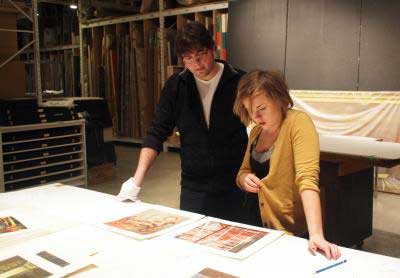Have you noticed that bridges are being built all over Lethbridge right now, linking the U of L to the broader community?
Exciting new opportunities are being offered each semester through the University of Lethbridge's Museum Studies Internship program. Each year, this program enables students to build connections with the community for their future careers. Those connections provide a plethora of benefits for students, the institutions they work with and the community as a whole.

Students enrolled in the internship option, which is part of the Bachelor of Fine Arts degree program, use their interests as a starting point to develop relationships with organizations in the community. These interests lead to internships where students gain valuable work experience and the hosting institutions benefit from having new and fresh perspectives. Interns become ambassadors for their institutions, sharing information with the broader community.
"Internships are a great way for students to gain insight into the career choices they are considering, and to acquire behind the scenes perspectives about how institutions operate," says Kevin MacLean, collections technician, Galt Museum and Archives.
Students who gain these insights have an advantage when envisioning their future because they have a clearer sense of the roles they want to occupy. By participating in the internship program, students further their careers by gaining practical hands-on experience, which employers are quick to recognize, and by networking within their career fields.
"My appreciation for public programming has definitely grown with my understanding of what goes into creating events," says Allison Spencer, curatorial intern with the U of L Art Gallery. During her internship, Spencer assisted in hosting public programming activities including Culture Vulture Saturdays as well as assisting exhibition planning.
Hosting an intern is also advantageous for the institution. Students bring enthusiasm, a desire to learn and a willingness to work diligently.
"It's an excellent way for an institution to achieve its vision, because the interns take on responsibility and help permanent staff to become more effective," says Ryan Doherty, SAAG Curator.
In non-profit institutions, volunteering is always encouraged and appreciated. Interns, although often unpaid, bridge the gap between permanent staff and casual volunteers by working regular hours and remaining a valuable resource of volunteer energy. Students who complete the internship program promote their institutions in a positive manner by communicating their learning experiences with others.
Granting opportunities to interns is highly beneficial to the community as well. When cultural institutions thrive, the community thrives as a result.
"Having interns is a great way for us to revitalize ourselves. Having new ideas and a fresh perspective allows us to reflect on how and why we do things the way we do. It adds a sense of vitality to our organization," says Marilyn Smith, SAAG Director.
This year SAAG, Galt Museum, and the U of L Art Gallery had interns in several capacities and expect to have more in the future.
"We welcome interns with an incredibly diverse range of opportunities and will work with students to create the experience that is right for them," says Lori Harasem, volunteer and special events co-ordinator with the Galt Museum.
Jennifer Vanderfluit, who interned at the Galt and worked with the archivist to complete a digital conservation project, readily recommends the experience to fellow students.
"I think the internship program is an incredible opportunity that students should take advantage of," she says. "Every major should have a similar program."
For a look at the Legend in a flipbook format, follow this link.
